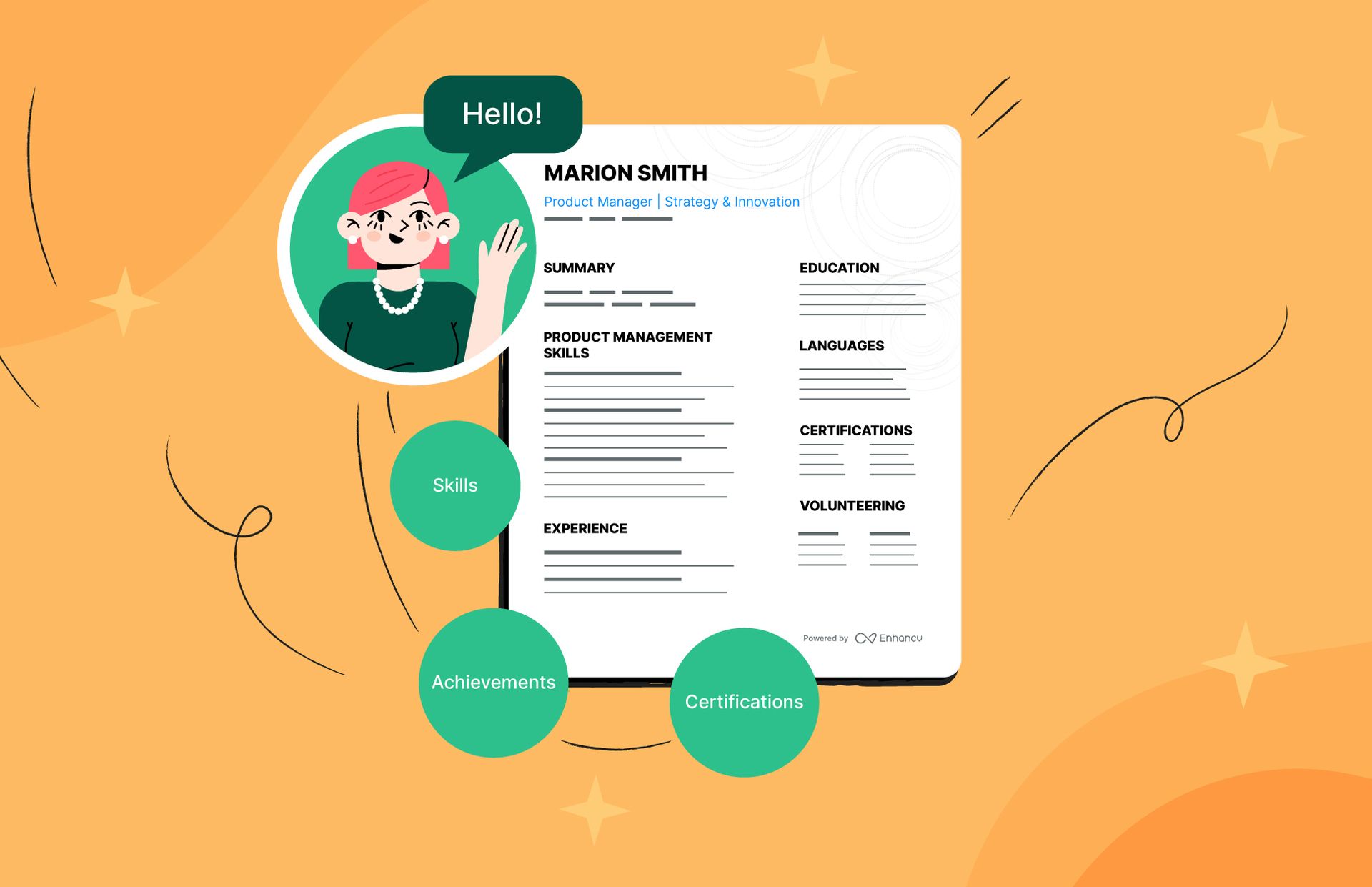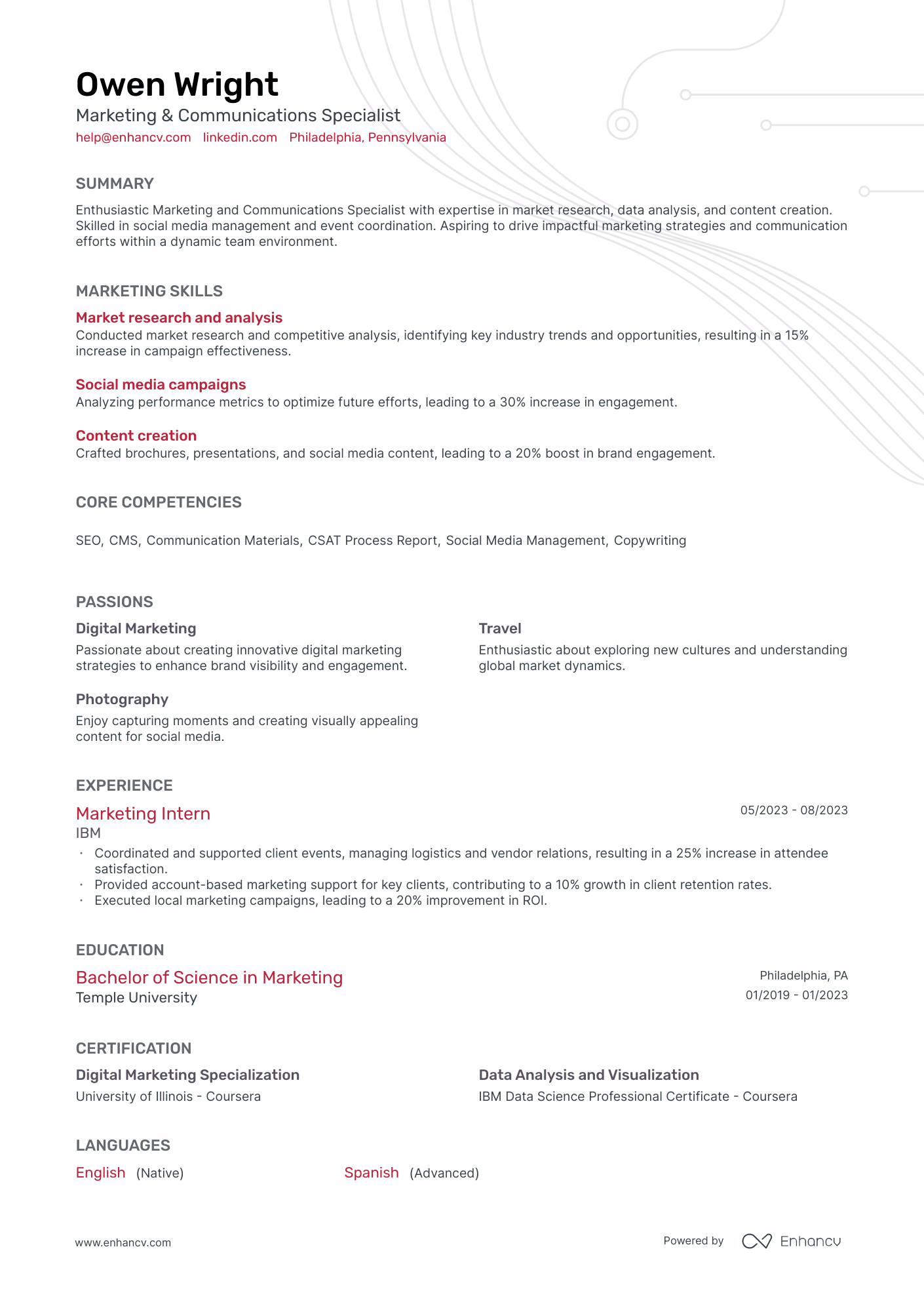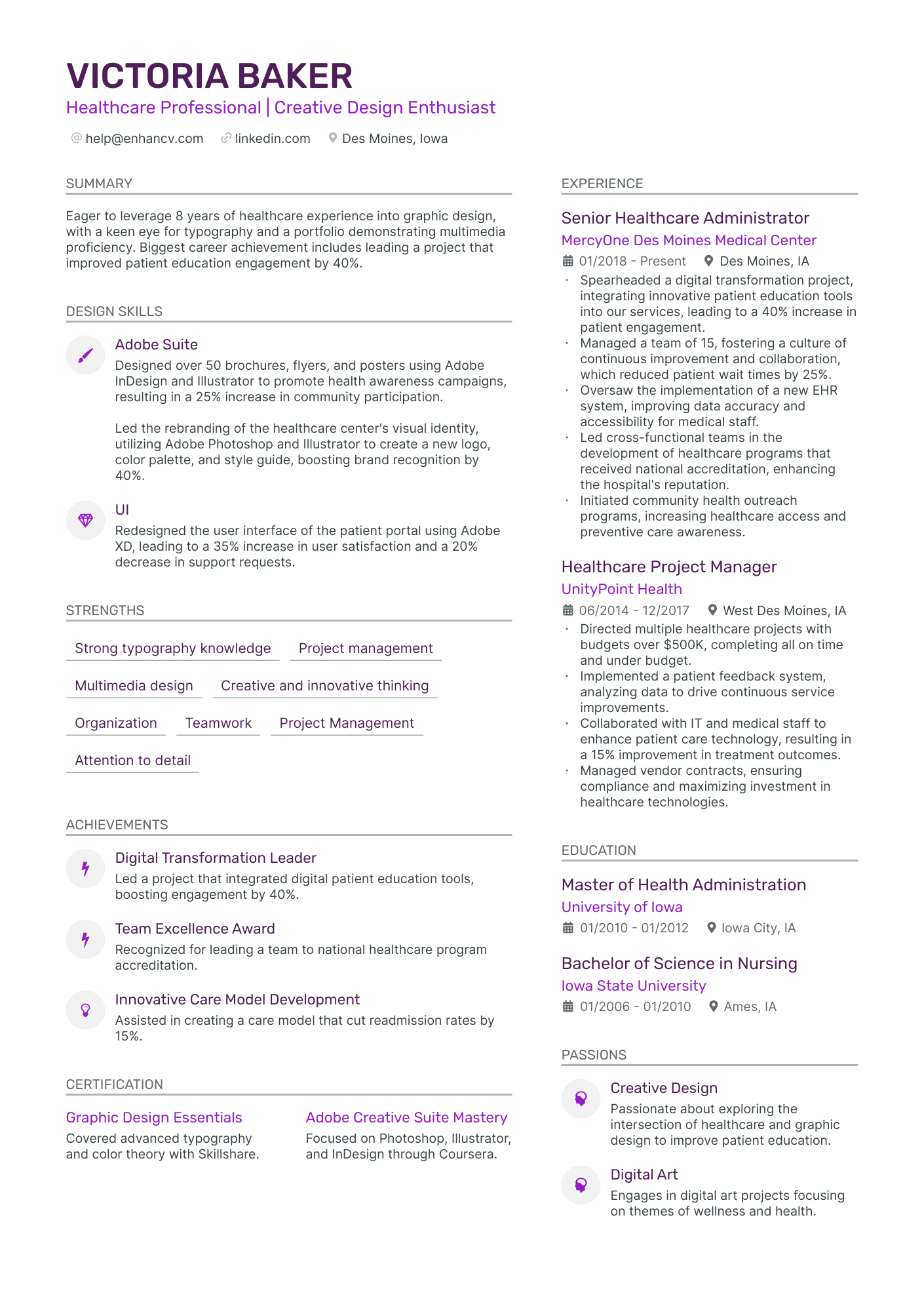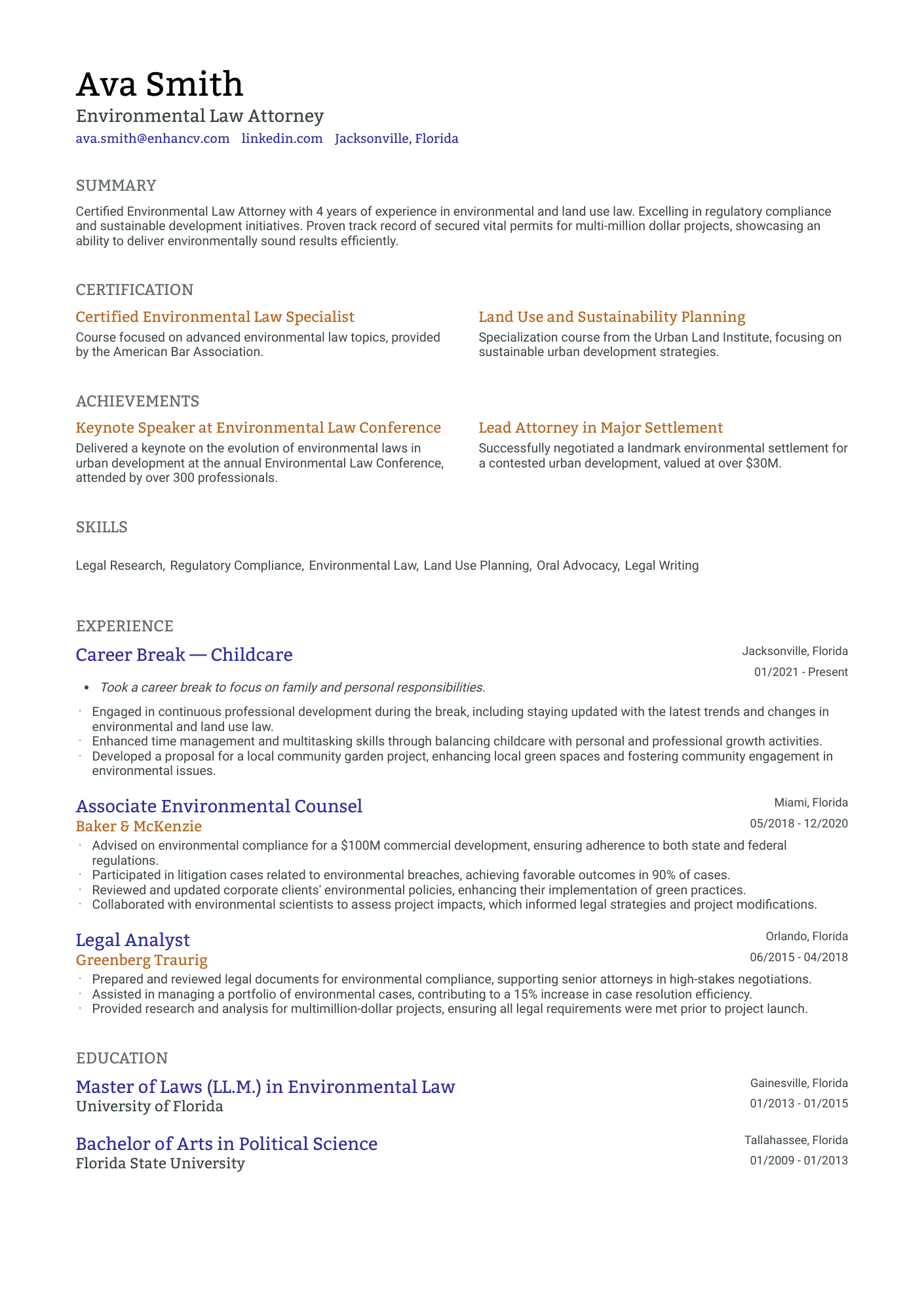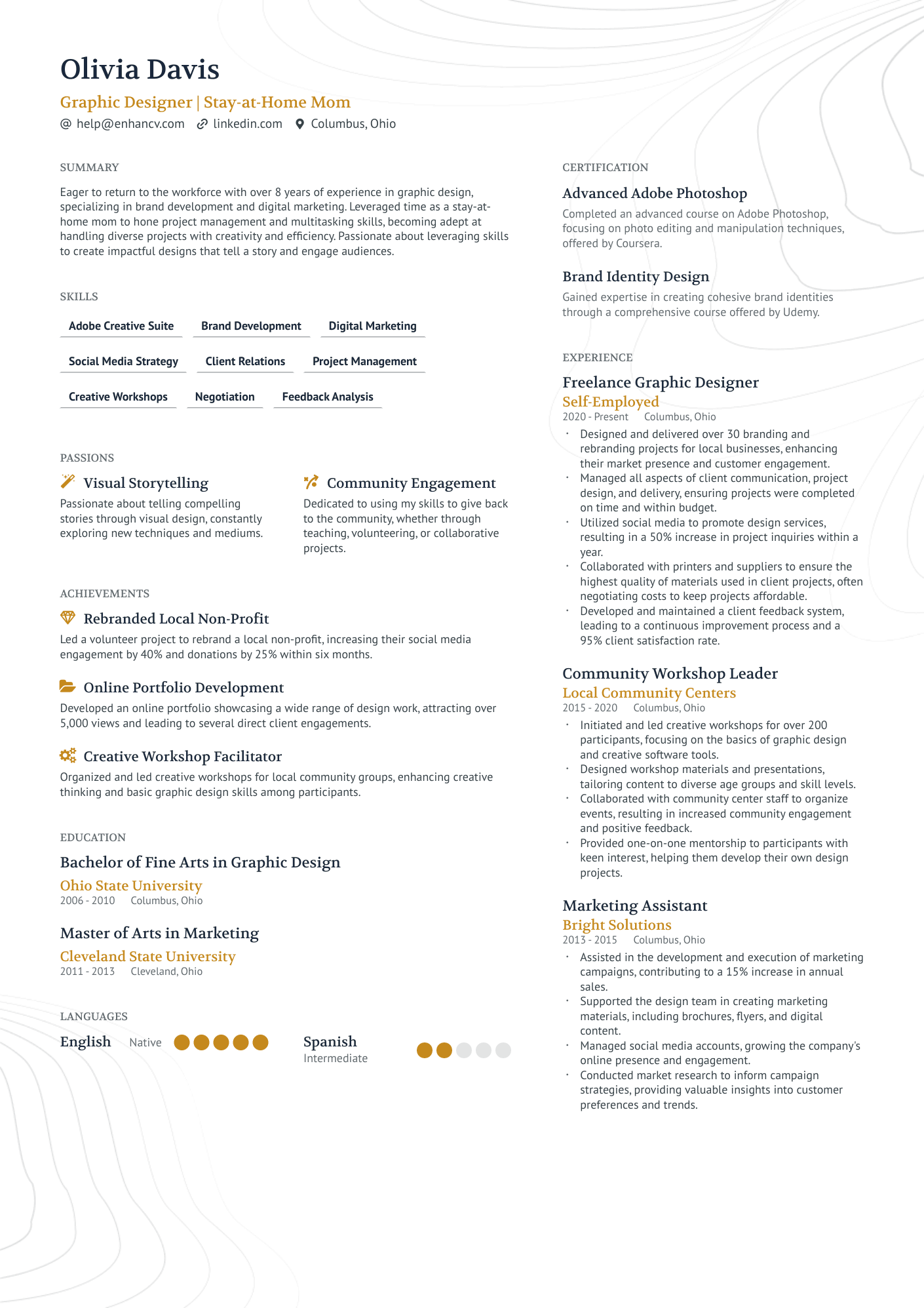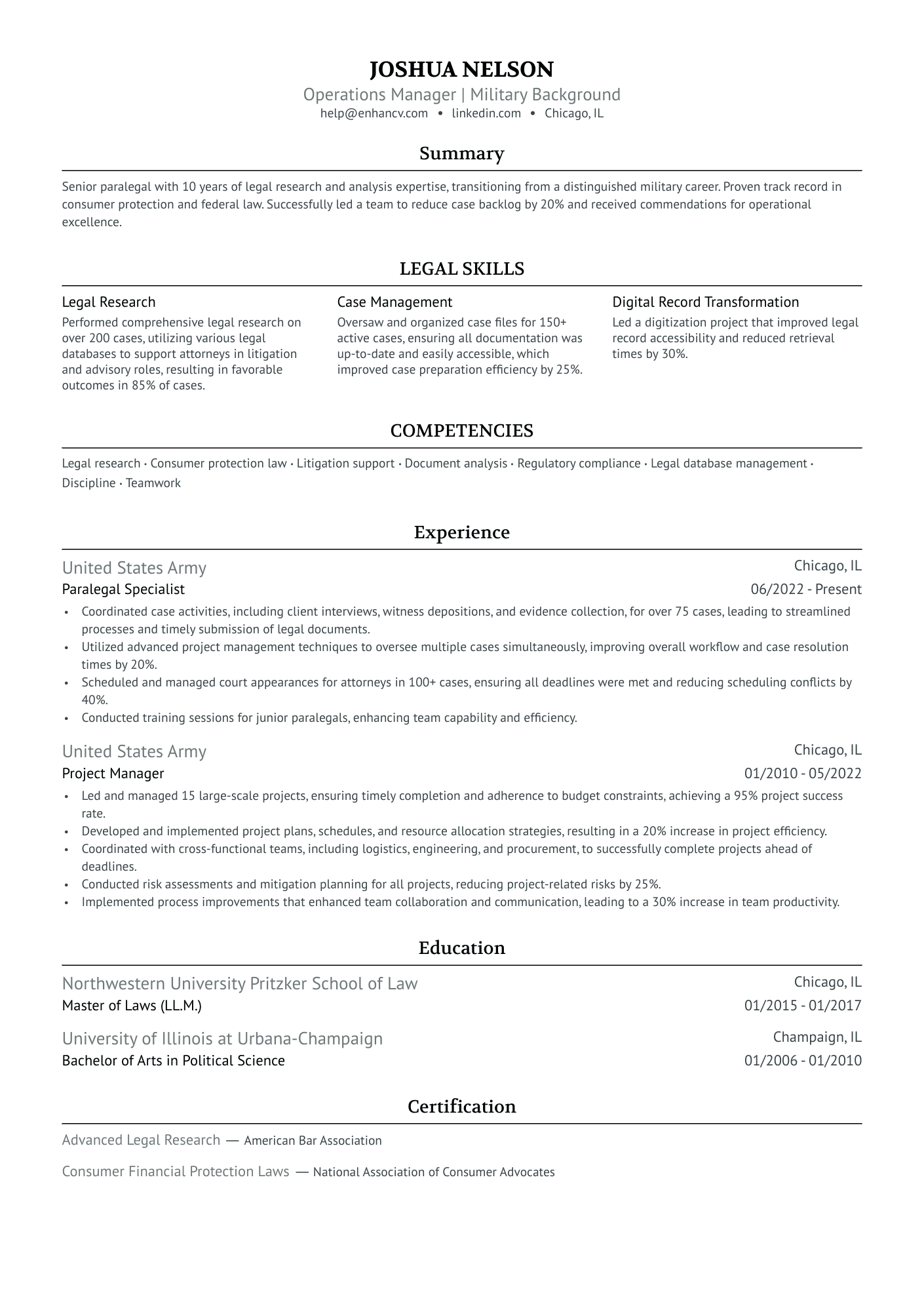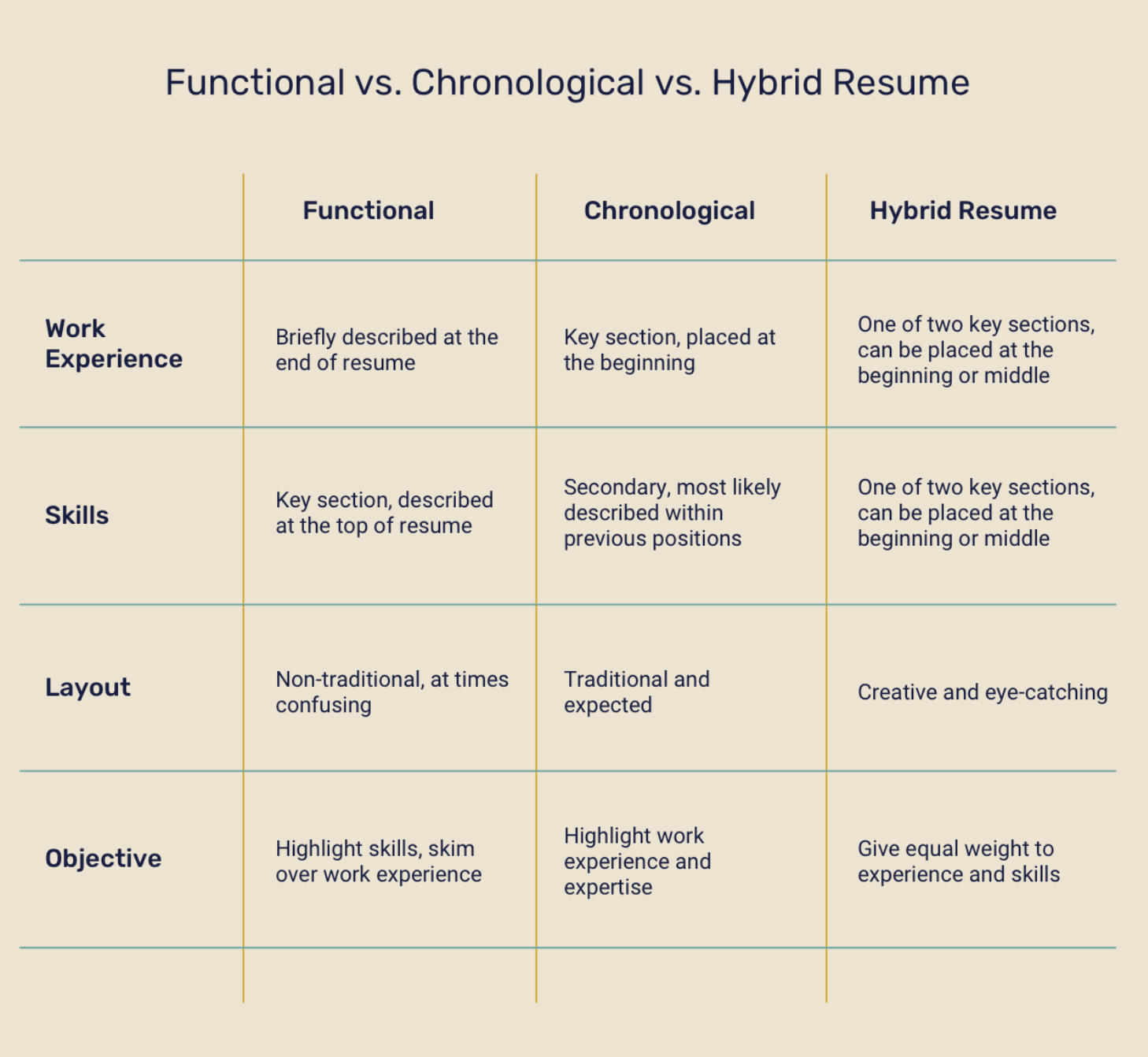Ever felt like your diverse skill set was getting lost in the traditional resume format? Maybe you’re not using the right structure to make your strengths truly shine. When you need a format that highlights your skills and expertise, rather than just listing your job history, the functional resume is your go-to. It organizes your talents into categories, making it easy for recruiters to see your qualifications at a glance.
The functional resume format is perfect for career changers or those with gaps in employment. It puts the spotlight on what you can do, not just where you’ve been.
This article will help you discover the benefits of the functional resume and see how others have successfully used it in their job searches. Or, if you’re ready to get started, you can check out our expertly designed functional resume templates.
Let’s dive in.
What is a functional resume format?
The functional a.k.a. a skill-based resume format is designed to focus on your skills and abilities, which is why it’s called ‘functional.’ Instead of emphasizing your chronological work history, it underlines what you can do and how well you can do it.
This format typically follows this general flow:
- Resume header
- Career statement
- Skills section (grouped by relevant categories)
- Work experience (supporting your skills)
- Optional — any other relevant sections such as certifications, projects, volunteering, or languages that enhance your application.
The functional resume is a favorite among job seekers who are changing careers, those with gaps in their employment history, or individuals with a diverse range of skills. It allows them to present their strengths and accomplishments upfront, making a strong impression on recruiters right away.
One of its biggest assets is flexibility — you can tailor it to your unique qualifications and experiences. We’ll dive deeper into customizing this format later in the article.
3 benefits of the functional resume format
Wondering how to make your resume stand out in a sea of applications? Here’s why a functional resume might be your secret weapon:
- Highlights relevant skills: The functional resume format allows you to showcase your most relevant skills and abilities right at the top. This is particularly beneficial for career changers or those with varied backgrounds, as it directs the recruiter's attention to what you can do rather than where you've worked.
- Minimizes employment gaps: If you have gaps in your employment history, a functional resume can help downplay these gaps by focusing on your skills and accomplishments instead of your chronological work history. This makes it easier to present a coherent and compelling narrative about your qualifications.
- Aligns with job requirements: With a functional resume, you can tailor your skills and experiences to match the specific job you're applying for. By organizing your resume around key skill areas, you can make a stronger case for how your background aligns with the job requirements, increasing your chances of catching the recruiter's eye.
Is your resume good enough?
Drop your resume here or choose a file. PDF & DOCX only. Max 2MB file size.
As a stay-at-home mom trying to get back into my position as an accountant, I was really worried that my career gap would overshadow my skills. I kept thinking recruiters would just see the time I was away and not all the new capabilities I’d developed. Switching to the functional resume format helped me showcase my strengths more confidently, focusing on what I can bring to the table now. It turned my anxiety into an opportunity to shine.
Rose Williams, Enhancv customer
When to choose the functional format & 5 resume examples
The functional resume format can be a game-changer for many job seekers, especially when your career path doesn’t follow a traditional trajectory. Here’s a closer look at when you might want to give this approach a try, together with some functional resume examples:
First-time job seekers
Starting your career journey can be daunting, especially when you lack professional experience. A functional resume allows you to underscore your skills, education, and any relevant volunteer work or internship roles. Instead of a sparse work history section, you can present the abilities that make you a strong candidate, giving recruiters a clear picture of what you bring to the table.
Get more expert tips on the topic in our article How to Write Your First Resume.
Career changers
If you’re switching careers, a functional resume can help you make a compelling case for your new direction. This format focuses on your transferable skills and accomplishments. By organizing your resume around your relevant abilities, you can show potential employers that you have the necessary qualifications for your new career, even if your work history is in a different field.
Work returners
Whether due to personal reasons, health issues, or other circumstances, employment gaps can make traditional resumes look choppy. A functional resume downplays these gaps by emphasizing your skills and achievements instead. This helps you present a more cohesive and positive narrative, demonstrating that your time away from work hasn’t diminished your professional capabilities.
If you’re a back-to-worker struggling to explain your career gap on your resume, you might find our special employment gap guide useful.
Stay-at-home parents
Reentering the workforce after spending time as a stay-at-home parent can be challenging. A functional resume lets you focus on the skills you’ve maintained and developed during your time at home, such as organization, multitasking, and managing household finances. By highlighting these strengths, you can reassure employers that you’re ready to step back into a professional role with confidence and competence.
Military
Transitioning from military service to civilian employment often requires translating military skills into civilian terms. A functional resume helps veterans showcase their leadership, discipline, and specialized training without being tied to a chronological job history. This format can effectively communicate your value to potential employers, bridging the gap between military and civilian work environments.
Pros and cons of the functional resume format
One of the biggest mistakes people make when choosing the functional resume format is not understanding when it’s appropriate to use it. Many opt for this structure to mask gaps in employment or a lack of direct experience, which can sometimes lead to more suspicion rather than reassurance from employers.
Despite this, the skill-based format does have its advantages and disadvantages. Here's a look at them:
Pros:
- Highlights skills: Emphasizes skills and abilities over chronological job history, useful for career changers.
- De-emphasizes gaps: Helps minimize the focus on employment gaps or short-term jobs.
- Focus on achievements: Allows candidates to showcase relevant accomplishments that align with the job they’re applying for.
- Flexibility: Offers flexibility in presenting an experience that might not fit a traditional job progression.
Cons:
- Lack of context: Not listing detailed employment history can make it harder for employers to understand your career progression.
- Employer suspicion: The functional resume can raise red flags for employers who may suspect you’re hiding something. Also, it’s not preferred by employers in traditional or conservative industries.
- ATS issues: Often less compatible with ATS which scans for chronological data.
- Verification difficulty: Makes it more challenging for employers to verify work experience and job performance.
Understanding when and how to use the functional resume format can make a big difference in the job application process. While it can be a powerful tool for certain situations, it's crucial to weigh these pros and cons before deciding if it’s the right choice for your specific circumstances.
A functional resume doesn't mean you're leaving out the experience section entirely. Instead, it shifts the focus away from your work history because it might not be very relevant or is limited. Even with this format, it's essential to quantify your skills and accomplishments with specific data and numbers. This way, you can effectively demonstrate your capabilities and the impact you've had, making a stronger case for why you're a good fit for the job.
How to write a functional resume step by step
The skill-based resume format is quite different from conventional resumes and this can help you stand out. With the education or work history section towards the end of your document, it allows employers to thoroughly see the light of your professional expertise first before getting into the other sections later. Let’s explore how you build a functional resume:
Resume header
The resume header is the section at the top of your resume serving as the first point of contact for recruiters. You can personalize it with contrasting colors and a larger font size to attract attention. It should contain the following details:
- Contact information: State your name, job title, and location. Make sure it also includes a professional email address.
- Links: Add a link to your portfolio or your LinkedIn profile.
- Resume photo: Generally, it’s best to omit photos to maintain focus on your qualifications and avoid potential biases.
Look at this example taken from a real-world NICU nurse resume:
Resume summary or objective
The next part of your functional resume is the resume profile, which should briefly overview your previous experience, skills, and future goals related to a specific job opening. We normally distinguish between two types—a career summary and an objective statement. Here’s how to write yours:
- A short paragraph: For a summary, write 3-5 sentences that highlight your best qualities, skills, and career goals. However, in your case, it might be a better idea to opt for an objective statement. It’s shorter, up to 3 sentences, and more suitable for entry-level candidates and career changers.
- Choice of words: Use strong adjectives to describe yourself and start each sentence with a dynamic verb. Avoid writing in the first-person perspective, as you don’t want to be perceived as arrogant.
- Finish up strong: Use the final sentence to reinforce your message. Make recruiters want to learn more about you.
Here’s how an aspiring store manager’s resume objective can look:
Skills section
With the functional format, the skills section is the most crucial part of the resume.
Start by identifying and grouping your skills into categories.
- Pick out 3-5 of your most relevant and strongest skills and consider if they fall into the soft skills or the hard skills group.
- Research the skills in demand for the job you’re applying for and align them with your strengths. Always tailor your resume skills to the job you’re targeting. The success of your functional resume depends on its relevance score.
- Last but not least, simply listing the skills won’t cut it. It's essential to support them with quantifiable results, whether they're in a dedicated skills section, the summary, or the work history section of your resume.
If you’re applying for a Java developer position, here’s how your skills can be listed:
This skills section makes a great addition to a functional resume because it not only lists relevant skills but also provides specific, quantified achievements that demonstrate the candidate's proficiency and impact. Contextualizing each skill with real-world applications highlights the candidate's capabilities and contributions, making a compelling case for their suitability for the job.
PRO TIP
Enhancv’s resume builder offers great flexibility for customizing and rearranging your skills. You can list them in an achievements or additional experience section, and even change titles and icons to suit your preferences. This approach enhances your resume by highlighting your abilities and accomplishments, rather than merely listing skills.
Work experience section
The work experience section on a functional resume is still important because it provides context for your skills and achievements. Even though the main focus is on your skills, this section helps employers see where and how you've applied those skills in real-world situations.
This is how your experience entries should be listed:
- Job title and company: Clearly state your most recent position and the company you worked for.
- Dates of employment: Include the month and year you started and ended each job.
- Job description: Optionally, add a short description of your role in the company, especially if it was a startup—recruiters will need more context about it.
- Bullet points: Write 3-5 bullet points about your main tasks, duties, and contributions. Whenever possible, include numbers or statistics to illustrate your impact (e.g., increased sales by 20%, managed a team of 10).
- Action verbs: Start each bullet entry with an action verb to showcase your initiative.
Here’s how an experience section can look for someone who’s looking to rejoin the workforce after a sabbatical.
- •Immersed in diverse architectural styles and techniques to broaden design perspectives and expertise.
- •Participated in workshops and collaborated with renowned architects and artists to refine creative and technical skills.
- •Conducted a comparative study of historical and contemporary architectural works across various regions of Spain.
Education section
Your education section should also be tailored to the job you're applying for. If you've completed coursework that developed specific skills, be sure to highlight it to boost your chances of getting noticed. The more relevant your education is to the job, the higher it should be placed on your resume.
Here’s how to list your educational background:
- Degree: Start with the highest degree you’ve obtained (e.g., Bachelor’s, Master’s, Ph.D.) and your major or field of study.
- University or college: Include the name of the institution where you earned your degree.
- Location: Mention the city and state (or country, if international) of the institution.
- Graduation date: Provide the month and year of your graduation. If you’re still studying, indicate your expected graduation date.
- Honors and awards: If applicable, list any honors, awards, or distinctions you received (e.g., summa cum laude, Dean’s List). If you’re fresh out of school, your GPA might come in handy, but only if it’s above 3.5.
- Certifications: Certifications can often be more valuable than a degree. If you have a certification that's highly relevant to your target job, make sure it's prominently displayed. This is especially important for hands-on roles, like the one shown below:
Additional sections
Add any other relevant sections that highlight your results-driven value and how you can help the organization achieve its goals. For example:
- Projects: To showcase specific projects where you've applied your skills successfully.
- Volunteer work: This can demonstrate your people skills and commitment.
- Awards and honors: Highlight any recognition you've received for your work.
- Language skills: Proficiency in multiple languages can be a great asset, especially if you’re looking for a job in an international company.
- Client testimonials: Include testimonials, especially from reputable individuals, to support your skills and experience.
PRO TIP
As with any other resume format, what you put on your resume should align with the job posting. A well-targeted functional resume quickly demonstrates your suitability for the role, increasing your chances of standing out in a competitive job market. By tailoring your resume to highlight the most relevant skills and experiences for the specific job, you make it easier for ATS to recognize your qualifications. Plus, it also piques recruiters' interest by directly addressing their needs.
Free functional resume template
Here is a sample template to help you effectively highlight your skills and achievements. For more inspiration, you can go through our functional resume template examples.
[Your name]
[Job Title]
Email: [email address]
Location: [location]
Phone: [your phone number]
LinkedIn: [Your LinkedIn Profile URL]
Objective
[Write a brief summary of your career goals and the value you can bring to the target job. Focus on your skills and achievements.]
Skills
Hard Skills
- [Skill 1]: [Brief description or achievement related to this skill]
- [Skill 2]: [Brief description or achievement related to this skill]
- [Skill 3]: [Brief description or achievement related to this skill]
- [Skill 4]: [Brief description or achievement related to this skill]
Tech Skills
- [Skill 1]: [Brief description or achievement related to this skill]
- [Skill 2]: [Brief description or achievement related to this skill]
- [Skill 3]: [Brief description or achievement related to this skill]
- [Skill 4]: [Brief description or achievement related to this skill]
Soft Skills
- [Skill 1]: [Brief description or achievement related to this skill]
- [Skill 2]: [Brief description or achievement related to this skill]
- [Skill 3]: [Brief description or achievement related to this skill]
- [Skill 4]: [Brief description or achievement related to this skill]
Experience
[Job Title]
[Company Name]
[Location, Year(s)]
- [Brief description of your responsibilities and achievements in this role]
Education
[Degree, Major]
[University Name, Graduation Year]
- [Relevant coursework or achievements]
Languages
- [Language 1]: [Proficiency level]
- [Language 2]: [Proficiency level]
Other resume formats
There are two other formats that suit the different needs of individuals with more substantial work experience.
- The reverse chronological resume is the most common type. It underlines your work history in order, starting with the most recent position, making it ideal for showcasing a steady career progression. This format is especially effective for demonstrating growth and consistent employment in a particular field. It’s also a recruiter's favorite as it allows them to easily see your current and relevant roles, which immediately grabs their attention. Additionally, this format is highly compatible with ATS.
- The combination (or hybrid) resume blends elements of both the reverse chronological and the functional formats, highlighting skills and achievements at the top, followed by a detailed work history. This format is great for showcasing relevant skills while also providing a clear employment timeline. It’s best for roles in project management, marketing, graphic design, and software development where a mix of technical and interpersonal skills is essential.
The table shows you how the three formats compare to each other.
Key takeaways
The functional resume, while less traditional, offers a unique way to underscore your skills and experiences. Here’s what it does best:
- Highlights skills over chronology: This format focuses on your abilities and achievements, making it ideal for showcasing what you can do rather than when you did it.
- Great for career changers: If you're transitioning into a new field, a functional resume emphasizes your transferable skills, helping you present yourself as a strong candidate despite a different background.
- Minimizes employment gaps: This format downplays gaps in your work history, allowing you to focus on your strengths and relevant experiences.
- Ideal for varied experience: If your work history includes diverse roles and industries, a functional resume consolidates your skills, providing a cohesive narrative.
- Helps new graduates: For those with limited work experience but strong skills and academic achievements, this format highlights what you bring to the table.
- Showcases volunteer work and projects: If you have significant volunteer experience or side projects, a functional resume allows you to underline these contributions effectively.
Make one that's truly you.

